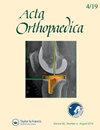A systematic review of crosswalks for converting patient-reported outcome measure scores in hip, knee, and shoulder replacement surgery.
IF 2.5
2区 医学
Q1 ORTHOPEDICS
引用次数: 0
Abstract
BACKGROUND AND PURPOSE We aimed to systematically review studies of crosswalks for converting patient-reported outcome measure (PROM) scores used in joint replacement, and develop a database of published crosswalks. METHODS 4 electronic databases were searched from January 2000 to May 2023 to identify studies reporting the development and/or validation of crosswalks to convert PROM scores in patients undergoing elective hip, knee, or shoulder replacement surgery. Data on study and sample characteristics, source and target PROMs, and crosswalk development and validation methods were extracted from eligible studies. Study reporting was evaluated using the Mapping onto Preference-based measures reporting Standards (MAPS) checklist. RESULTS 17 studies describing 35 crosswalks were eligible for inclusion. Unidirectional crosswalks were available to convert hip-specific (Oxford Hip Score [OHS]) and knee-specific (Oxford Knee Score [OKS]) scores to the EQ-5D-3L/EQ-5D-5L. Similar crosswalks to convert disease-specific scores (WOMAC) to the EQ-5D-3L, EQ-5D-5L, and ICECAP-O Capability Index were identified. Bidirectional crosswalks for converting OHS and OKS to the HOOS-JR/HOOS-12 and KOOS-JR/KOOS-12, for converting WOMAC to the HOOS-JR/KOOS-JR, and for converting HOOS-Function/KOOS-Function to the PROMIS-Physical Function were also available. Additionally, crosswalks to convert generic PROM scores from the UCLA Activity Scale to the Lower Extremity Activity Scale in both directions were available. No crosswalks were identified for converting scores in shoulder replacement. Development methods varied with the type of target score; most studies used regression, item response theory, or equipercentile equating approaches. Reporting quality was variable, particularly for methods and results items, impacting crosswalk application. CONCLUSION This is the first synthesis of published crosswalks for converting joint-specific (OHS, OKS, HOOS, KOOS), disease-specific (WOMAC), and generic PROMs scores (PROMIS-Physical Function, UCLA Activity Scale, Lower Extremity Activity Scale) used to assess joint replacement outcomes, providing a resource for data harmonization and pooled analysis. Crosswalks were developed using regression methods (9 studies), equipercentile equating methods (5 studies), a combination of equipercentile equating and item response theory methods (2 studies), and a combination of regression and equipercentile equating methods (1 study). A range of crosswalk validation approaches were adopted, including the use of external datasets, separate samples or subsets, follow-up data from additional time points, or bootstrapped samples. Efforts are needed to standardize crosswalk methodology and achieve consistent reporting.对髋关节、膝关节和肩关节置换手术中用于转换患者报告结果测量评分的横道图进行系统回顾。
背景和目的我们的目的是系统地回顾用于转换关节置换术中患者报告结果测量指标(PROM)评分的横道图研究,并建立一个已发表的横道图数据库。方法检索了 2000 年 1 月至 2023 年 5 月期间的 4 个电子数据库,以确定报告开发和/或验证横道图以转换接受择期髋、膝或肩关节置换手术患者的 PROM 评分的研究。从符合条件的研究中提取了有关研究和样本特征、源和目标 PROM 以及横道开发和验证方法的数据。研究报告采用基于偏好的测量报告标准(MAPS)核对表进行评估。结果 17 项研究描述了 35 条横道,符合纳入条件。单向横道可将髋关节特异性评分(牛津髋关节评分 [OHS])和膝关节特异性评分(牛津膝关节评分 [OKS])转换为 EQ-5D-3L/EQ-5D-5L。我们还找到了将疾病特异性评分(WOMAC)转换为 EQ-5D-3L、EQ-5D-5L 和 ICECAP-O 能力指数的类似交叉途径。还提供了将 OHS 和 OKS 转换为 HOOS-JR/HOOS-12 和 KOOS-JR/KOOS-12、将 WOMAC 转换为 HOOS-JR/KOOS-JR 以及将 HOOS-Function/KOOS-Function 转换为 PROMIS-Physical Function 的双向横道。此外,还提供了将通用 PROM 分数从 UCLA 活动量表双向转换为下肢活动量表的交叉通道。在肩关节置换术中,没有找到用于转换评分的横道图。开发方法因目标评分类型而异;大多数研究采用回归法、项目反应理论或等位等分法。结论 这是首次对已发表的用于关节置换结果评估的关节特异性(OHS、OKS、HOOS、KOOS)、疾病特异性(WOMAC)和通用 PROMs(PROMIS-物理功能、UCLA 活动量表、下肢活动量表)评分转换的横道图进行综合,为数据协调和汇总分析提供了资源。采用回归法(9 项研究)、等分等值法(5 项研究)、等分等值法与项目反应理论相结合的方法(2 项研究)以及回归法与等分等值法相结合的方法(1 项研究)制定了横道图。研究采用了一系列交叉验证方法,包括使用外部数据集、独立样本或子集、额外时间点的随访数据或自举样本。需要努力实现交叉分析方法的标准化和报告的一致性。
本文章由计算机程序翻译,如有差异,请以英文原文为准。
求助全文
约1分钟内获得全文
求助全文
来源期刊

Acta Orthopaedica
医学-整形外科
CiteScore
6.40
自引率
8.10%
发文量
105
审稿时长
4-8 weeks
期刊介绍:
Acta Orthopaedica (previously Acta Orthopaedica Scandinavica) presents original articles of basic research interest, as well as clinical studies in the field of orthopedics and related sub disciplines. Ever since the journal was founded in 1930, by a group of Scandinavian orthopedic surgeons, the journal has been published for an international audience. Acta Orthopaedica is owned by the Nordic Orthopaedic Federation and is the official publication of this federation.
 求助内容:
求助内容: 应助结果提醒方式:
应助结果提醒方式:


